Analyzing Tourism Industry Reforms and Impacts on Australian Growth
VerifiedAdded on 2023/06/04
|12
|3233
|53
Essay
AI Summary
This essay examines the reforms implemented in Australia's tourism industry and their subsequent impact on the nation's economic growth. It highlights the crucial role of the tourism sector, contributing over 3% to Australia's GDP, with a significant portion derived from international tourists. The reforms discussed include encouraging investment through regulatory changes, addressing labor supply challenges via education and recruitment initiatives, improving infrastructure for visitor transportation, and promoting digital adoption within the industry. The essay also assesses the positive effects of these reforms, such as increased consumer expenditure, job creation, and overall contribution to the Australian economy, noting its fluctuations and future growth potential. This document is available on Desklib, a platform offering a wide range of study resources, including past papers and solved assignments, to support students' academic endeavors.
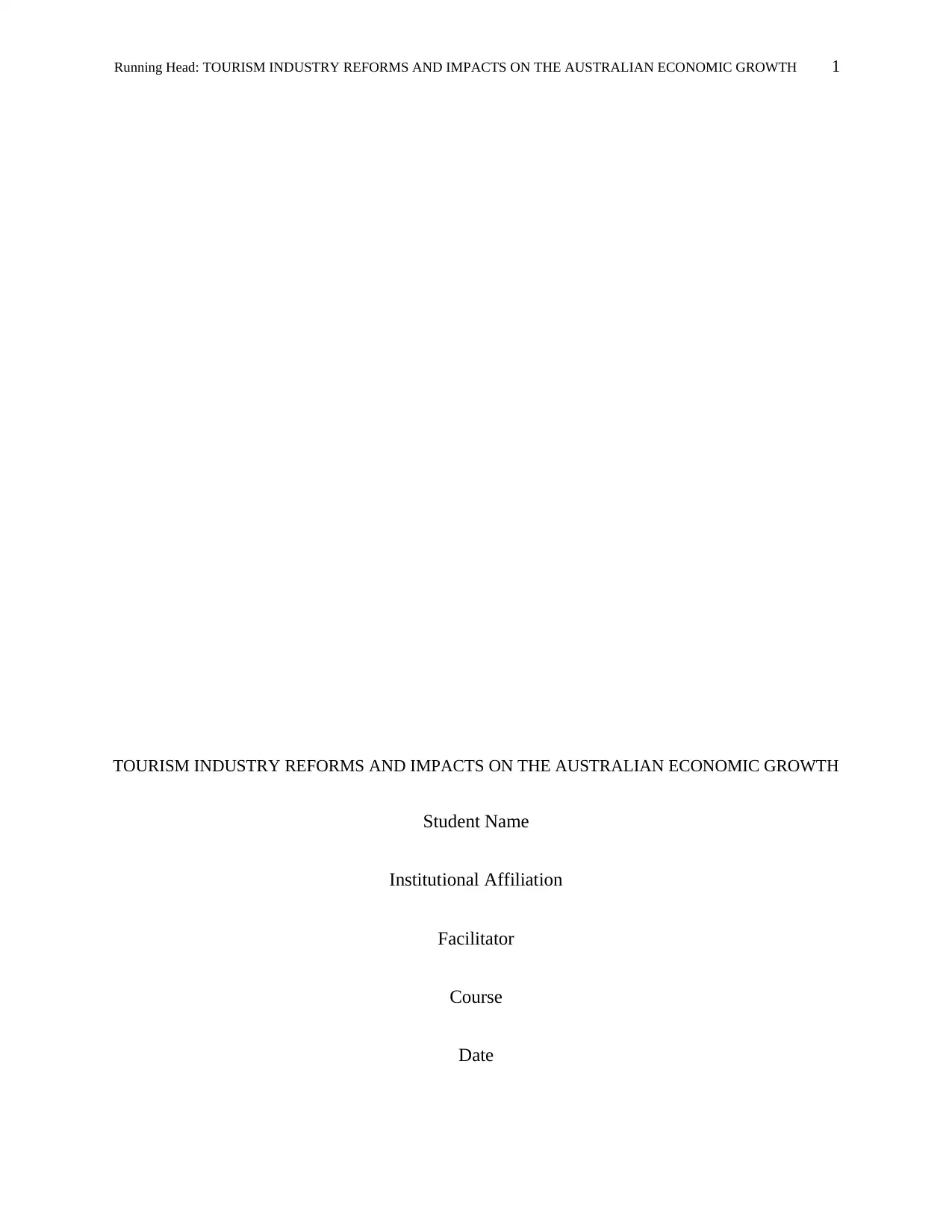
Running Head: TOURISM INDUSTRY REFORMS AND IMPACTS ON THE AUSTRALIAN ECONOMIC GROWTH 1
TOURISM INDUSTRY REFORMS AND IMPACTS ON THE AUSTRALIAN ECONOMIC GROWTH
Student Name
Institutional Affiliation
Facilitator
Course
Date
TOURISM INDUSTRY REFORMS AND IMPACTS ON THE AUSTRALIAN ECONOMIC GROWTH
Student Name
Institutional Affiliation
Facilitator
Course
Date
Paraphrase This Document
Need a fresh take? Get an instant paraphrase of this document with our AI Paraphraser
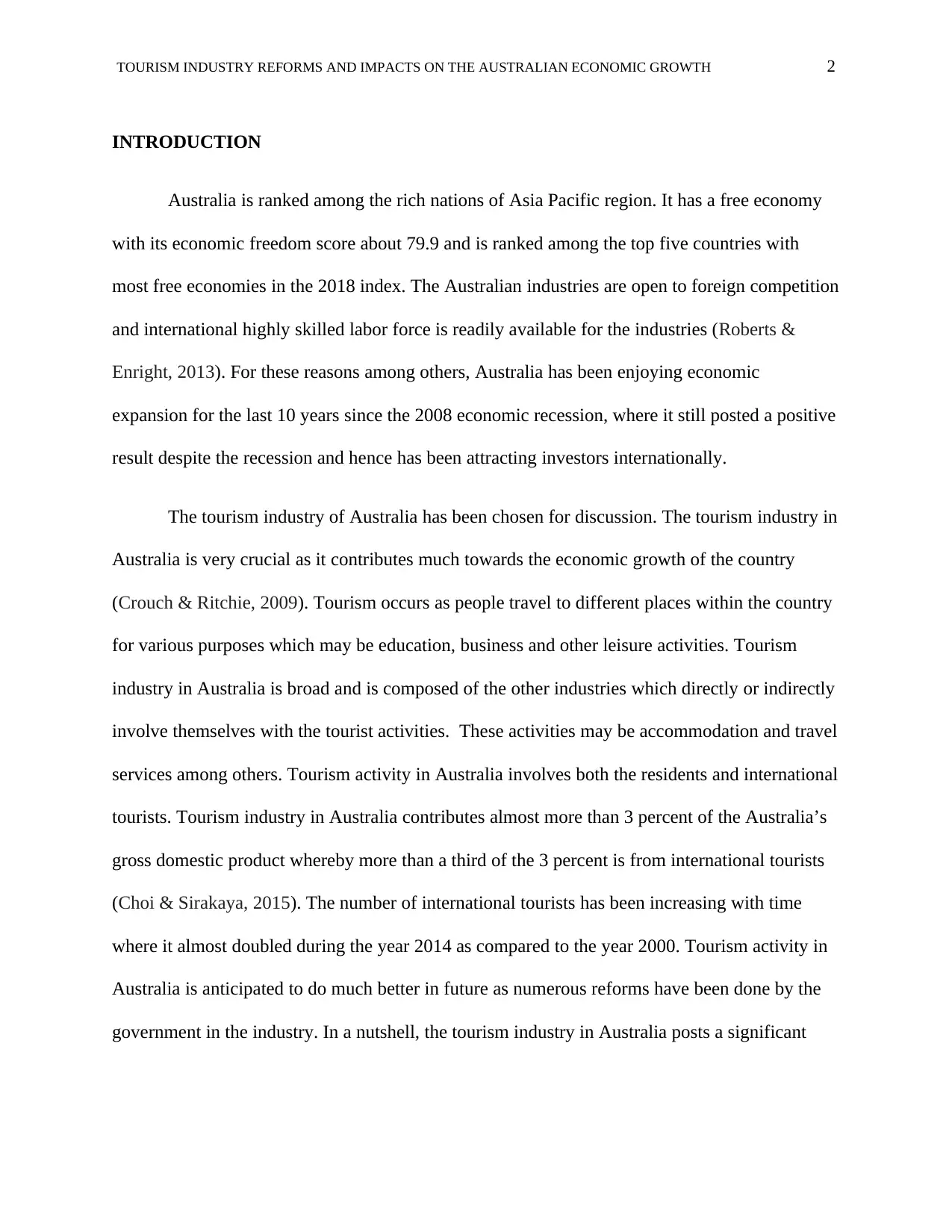
TOURISM INDUSTRY REFORMS AND IMPACTS ON THE AUSTRALIAN ECONOMIC GROWTH 2
INTRODUCTION
Australia is ranked among the rich nations of Asia Pacific region. It has a free economy
with its economic freedom score about 79.9 and is ranked among the top five countries with
most free economies in the 2018 index. The Australian industries are open to foreign competition
and international highly skilled labor force is readily available for the industries (Roberts &
Enright, 2013). For these reasons among others, Australia has been enjoying economic
expansion for the last 10 years since the 2008 economic recession, where it still posted a positive
result despite the recession and hence has been attracting investors internationally.
The tourism industry of Australia has been chosen for discussion. The tourism industry in
Australia is very crucial as it contributes much towards the economic growth of the country
(Crouch & Ritchie, 2009). Tourism occurs as people travel to different places within the country
for various purposes which may be education, business and other leisure activities. Tourism
industry in Australia is broad and is composed of the other industries which directly or indirectly
involve themselves with the tourist activities. These activities may be accommodation and travel
services among others. Tourism activity in Australia involves both the residents and international
tourists. Tourism industry in Australia contributes almost more than 3 percent of the Australia’s
gross domestic product whereby more than a third of the 3 percent is from international tourists
(Choi & Sirakaya, 2015). The number of international tourists has been increasing with time
where it almost doubled during the year 2014 as compared to the year 2000. Tourism activity in
Australia is anticipated to do much better in future as numerous reforms have been done by the
government in the industry. In a nutshell, the tourism industry in Australia posts a significant
INTRODUCTION
Australia is ranked among the rich nations of Asia Pacific region. It has a free economy
with its economic freedom score about 79.9 and is ranked among the top five countries with
most free economies in the 2018 index. The Australian industries are open to foreign competition
and international highly skilled labor force is readily available for the industries (Roberts &
Enright, 2013). For these reasons among others, Australia has been enjoying economic
expansion for the last 10 years since the 2008 economic recession, where it still posted a positive
result despite the recession and hence has been attracting investors internationally.
The tourism industry of Australia has been chosen for discussion. The tourism industry in
Australia is very crucial as it contributes much towards the economic growth of the country
(Crouch & Ritchie, 2009). Tourism occurs as people travel to different places within the country
for various purposes which may be education, business and other leisure activities. Tourism
industry in Australia is broad and is composed of the other industries which directly or indirectly
involve themselves with the tourist activities. These activities may be accommodation and travel
services among others. Tourism activity in Australia involves both the residents and international
tourists. Tourism industry in Australia contributes almost more than 3 percent of the Australia’s
gross domestic product whereby more than a third of the 3 percent is from international tourists
(Choi & Sirakaya, 2015). The number of international tourists has been increasing with time
where it almost doubled during the year 2014 as compared to the year 2000. Tourism activity in
Australia is anticipated to do much better in future as numerous reforms have been done by the
government in the industry. In a nutshell, the tourism industry in Australia posts a significant
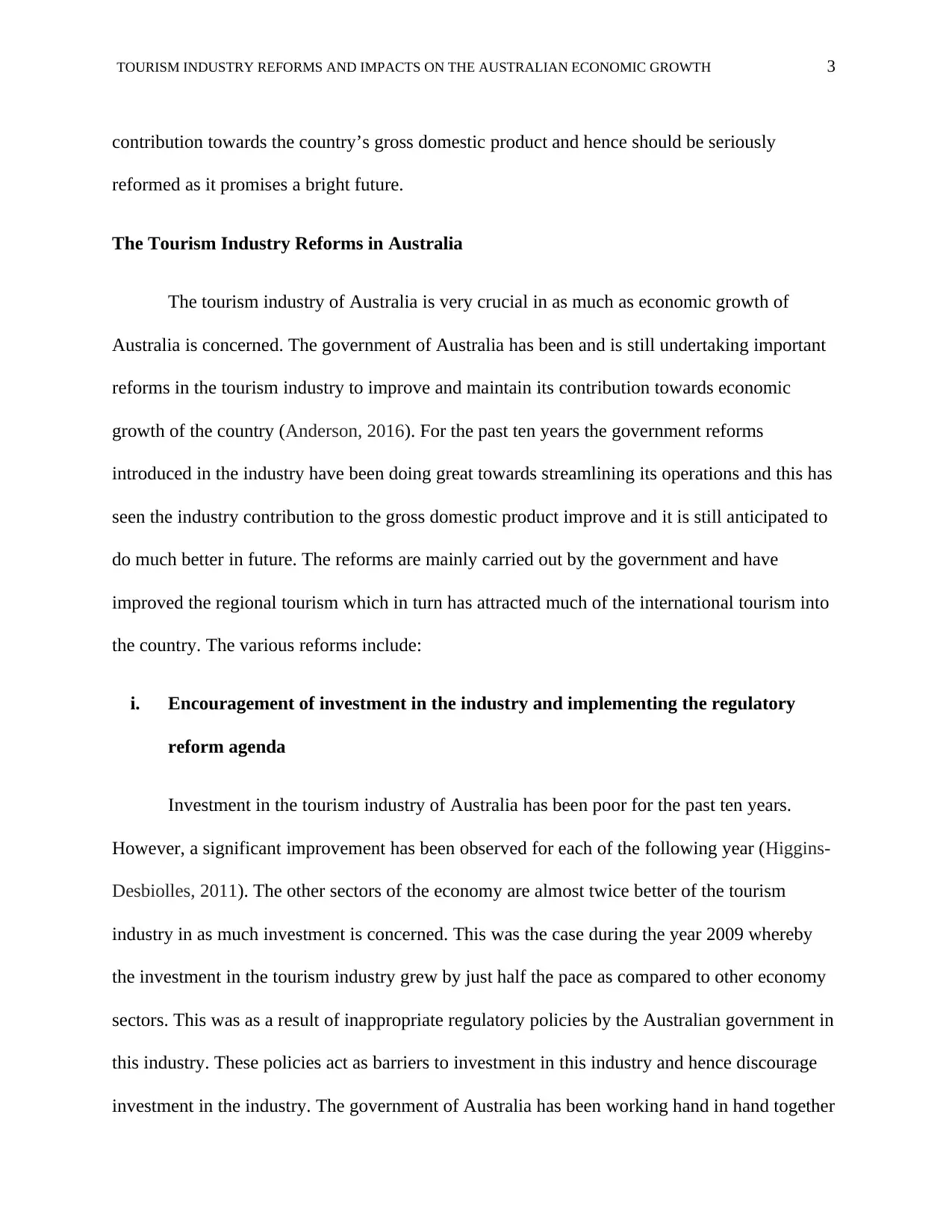
TOURISM INDUSTRY REFORMS AND IMPACTS ON THE AUSTRALIAN ECONOMIC GROWTH 3
contribution towards the country’s gross domestic product and hence should be seriously
reformed as it promises a bright future.
The Tourism Industry Reforms in Australia
The tourism industry of Australia is very crucial in as much as economic growth of
Australia is concerned. The government of Australia has been and is still undertaking important
reforms in the tourism industry to improve and maintain its contribution towards economic
growth of the country (Anderson, 2016). For the past ten years the government reforms
introduced in the industry have been doing great towards streamlining its operations and this has
seen the industry contribution to the gross domestic product improve and it is still anticipated to
do much better in future. The reforms are mainly carried out by the government and have
improved the regional tourism which in turn has attracted much of the international tourism into
the country. The various reforms include:
i. Encouragement of investment in the industry and implementing the regulatory
reform agenda
Investment in the tourism industry of Australia has been poor for the past ten years.
However, a significant improvement has been observed for each of the following year (Higgins-
Desbiolles, 2011). The other sectors of the economy are almost twice better of the tourism
industry in as much investment is concerned. This was the case during the year 2009 whereby
the investment in the tourism industry grew by just half the pace as compared to other economy
sectors. This was as a result of inappropriate regulatory policies by the Australian government in
this industry. These policies act as barriers to investment in this industry and hence discourage
investment in the industry. The government of Australia has been working hand in hand together
contribution towards the country’s gross domestic product and hence should be seriously
reformed as it promises a bright future.
The Tourism Industry Reforms in Australia
The tourism industry of Australia is very crucial in as much as economic growth of
Australia is concerned. The government of Australia has been and is still undertaking important
reforms in the tourism industry to improve and maintain its contribution towards economic
growth of the country (Anderson, 2016). For the past ten years the government reforms
introduced in the industry have been doing great towards streamlining its operations and this has
seen the industry contribution to the gross domestic product improve and it is still anticipated to
do much better in future. The reforms are mainly carried out by the government and have
improved the regional tourism which in turn has attracted much of the international tourism into
the country. The various reforms include:
i. Encouragement of investment in the industry and implementing the regulatory
reform agenda
Investment in the tourism industry of Australia has been poor for the past ten years.
However, a significant improvement has been observed for each of the following year (Higgins-
Desbiolles, 2011). The other sectors of the economy are almost twice better of the tourism
industry in as much investment is concerned. This was the case during the year 2009 whereby
the investment in the tourism industry grew by just half the pace as compared to other economy
sectors. This was as a result of inappropriate regulatory policies by the Australian government in
this industry. These policies act as barriers to investment in this industry and hence discourage
investment in the industry. The government of Australia has been working hand in hand together
⊘ This is a preview!⊘
Do you want full access?
Subscribe today to unlock all pages.

Trusted by 1+ million students worldwide
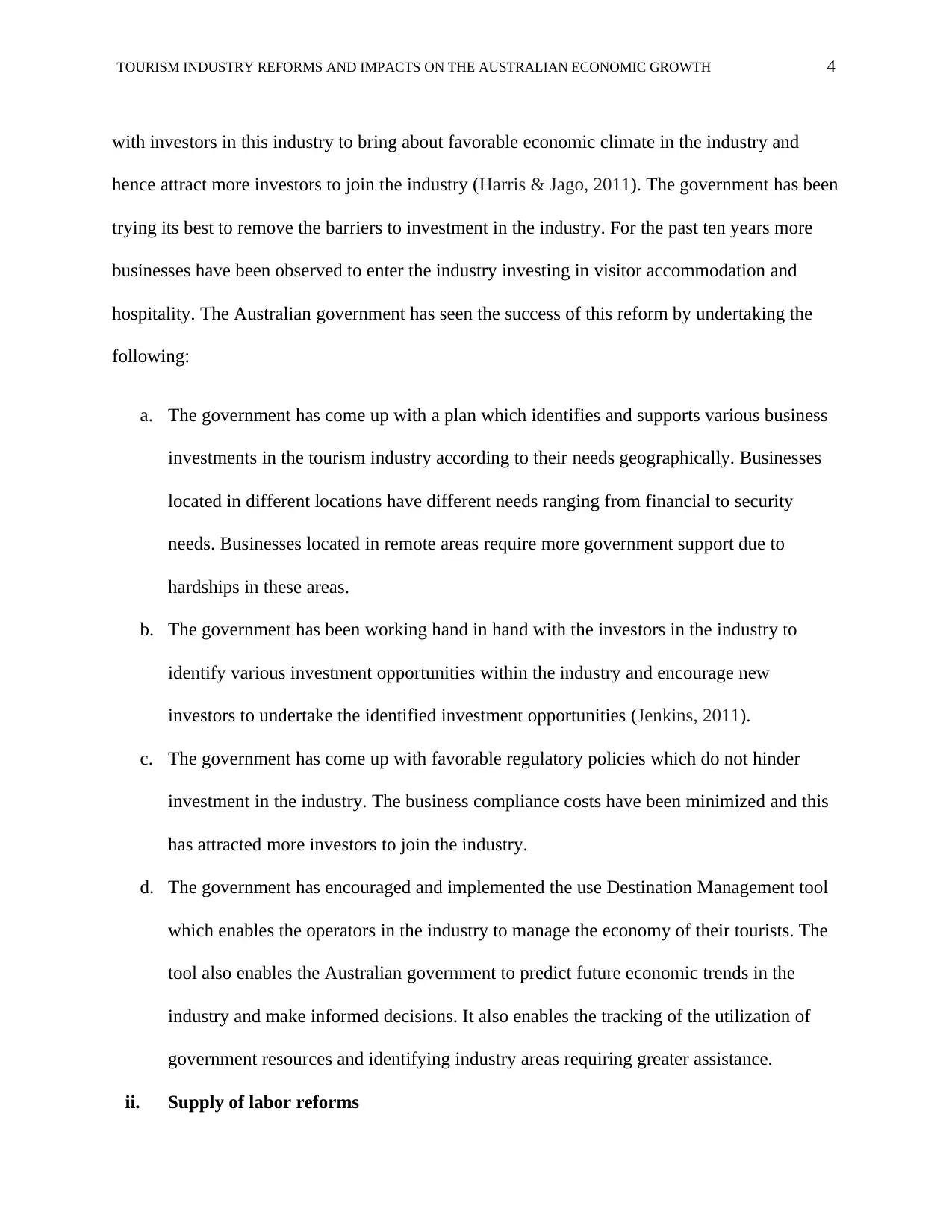
TOURISM INDUSTRY REFORMS AND IMPACTS ON THE AUSTRALIAN ECONOMIC GROWTH 4
with investors in this industry to bring about favorable economic climate in the industry and
hence attract more investors to join the industry (Harris & Jago, 2011). The government has been
trying its best to remove the barriers to investment in the industry. For the past ten years more
businesses have been observed to enter the industry investing in visitor accommodation and
hospitality. The Australian government has seen the success of this reform by undertaking the
following:
a. The government has come up with a plan which identifies and supports various business
investments in the tourism industry according to their needs geographically. Businesses
located in different locations have different needs ranging from financial to security
needs. Businesses located in remote areas require more government support due to
hardships in these areas.
b. The government has been working hand in hand with the investors in the industry to
identify various investment opportunities within the industry and encourage new
investors to undertake the identified investment opportunities (Jenkins, 2011).
c. The government has come up with favorable regulatory policies which do not hinder
investment in the industry. The business compliance costs have been minimized and this
has attracted more investors to join the industry.
d. The government has encouraged and implemented the use Destination Management tool
which enables the operators in the industry to manage the economy of their tourists. The
tool also enables the Australian government to predict future economic trends in the
industry and make informed decisions. It also enables the tracking of the utilization of
government resources and identifying industry areas requiring greater assistance.
ii. Supply of labor reforms
with investors in this industry to bring about favorable economic climate in the industry and
hence attract more investors to join the industry (Harris & Jago, 2011). The government has been
trying its best to remove the barriers to investment in the industry. For the past ten years more
businesses have been observed to enter the industry investing in visitor accommodation and
hospitality. The Australian government has seen the success of this reform by undertaking the
following:
a. The government has come up with a plan which identifies and supports various business
investments in the tourism industry according to their needs geographically. Businesses
located in different locations have different needs ranging from financial to security
needs. Businesses located in remote areas require more government support due to
hardships in these areas.
b. The government has been working hand in hand with the investors in the industry to
identify various investment opportunities within the industry and encourage new
investors to undertake the identified investment opportunities (Jenkins, 2011).
c. The government has come up with favorable regulatory policies which do not hinder
investment in the industry. The business compliance costs have been minimized and this
has attracted more investors to join the industry.
d. The government has encouraged and implemented the use Destination Management tool
which enables the operators in the industry to manage the economy of their tourists. The
tool also enables the Australian government to predict future economic trends in the
industry and make informed decisions. It also enables the tracking of the utilization of
government resources and identifying industry areas requiring greater assistance.
ii. Supply of labor reforms
Paraphrase This Document
Need a fresh take? Get an instant paraphrase of this document with our AI Paraphraser
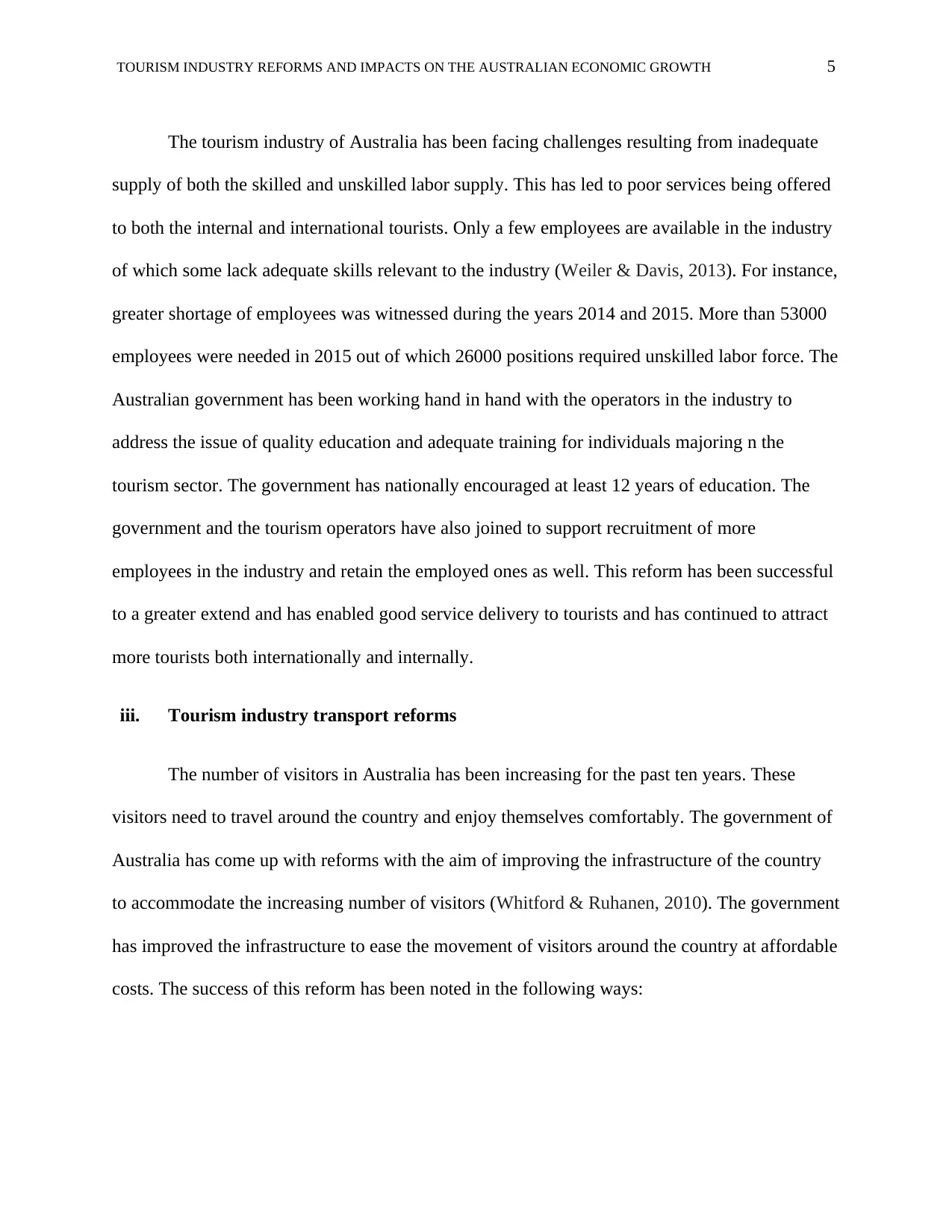
TOURISM INDUSTRY REFORMS AND IMPACTS ON THE AUSTRALIAN ECONOMIC GROWTH 5
The tourism industry of Australia has been facing challenges resulting from inadequate
supply of both the skilled and unskilled labor supply. This has led to poor services being offered
to both the internal and international tourists. Only a few employees are available in the industry
of which some lack adequate skills relevant to the industry (Weiler & Davis, 2013). For instance,
greater shortage of employees was witnessed during the years 2014 and 2015. More than 53000
employees were needed in 2015 out of which 26000 positions required unskilled labor force. The
Australian government has been working hand in hand with the operators in the industry to
address the issue of quality education and adequate training for individuals majoring n the
tourism sector. The government has nationally encouraged at least 12 years of education. The
government and the tourism operators have also joined to support recruitment of more
employees in the industry and retain the employed ones as well. This reform has been successful
to a greater extend and has enabled good service delivery to tourists and has continued to attract
more tourists both internationally and internally.
iii. Tourism industry transport reforms
The number of visitors in Australia has been increasing for the past ten years. These
visitors need to travel around the country and enjoy themselves comfortably. The government of
Australia has come up with reforms with the aim of improving the infrastructure of the country
to accommodate the increasing number of visitors (Whitford & Ruhanen, 2010). The government
has improved the infrastructure to ease the movement of visitors around the country at affordable
costs. The success of this reform has been noted in the following ways:
The tourism industry of Australia has been facing challenges resulting from inadequate
supply of both the skilled and unskilled labor supply. This has led to poor services being offered
to both the internal and international tourists. Only a few employees are available in the industry
of which some lack adequate skills relevant to the industry (Weiler & Davis, 2013). For instance,
greater shortage of employees was witnessed during the years 2014 and 2015. More than 53000
employees were needed in 2015 out of which 26000 positions required unskilled labor force. The
Australian government has been working hand in hand with the operators in the industry to
address the issue of quality education and adequate training for individuals majoring n the
tourism sector. The government has nationally encouraged at least 12 years of education. The
government and the tourism operators have also joined to support recruitment of more
employees in the industry and retain the employed ones as well. This reform has been successful
to a greater extend and has enabled good service delivery to tourists and has continued to attract
more tourists both internationally and internally.
iii. Tourism industry transport reforms
The number of visitors in Australia has been increasing for the past ten years. These
visitors need to travel around the country and enjoy themselves comfortably. The government of
Australia has come up with reforms with the aim of improving the infrastructure of the country
to accommodate the increasing number of visitors (Whitford & Ruhanen, 2010). The government
has improved the infrastructure to ease the movement of visitors around the country at affordable
costs. The success of this reform has been noted in the following ways:
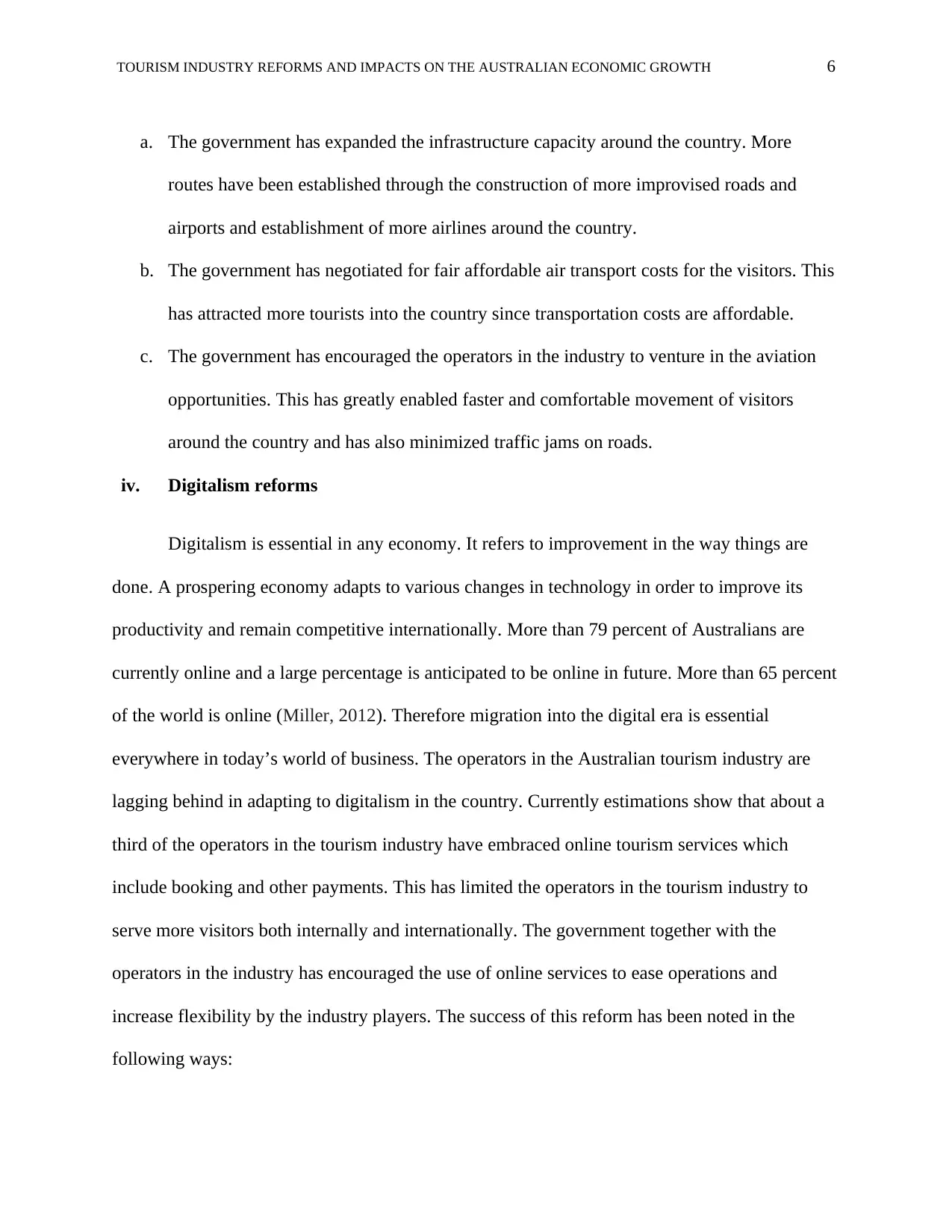
TOURISM INDUSTRY REFORMS AND IMPACTS ON THE AUSTRALIAN ECONOMIC GROWTH 6
a. The government has expanded the infrastructure capacity around the country. More
routes have been established through the construction of more improvised roads and
airports and establishment of more airlines around the country.
b. The government has negotiated for fair affordable air transport costs for the visitors. This
has attracted more tourists into the country since transportation costs are affordable.
c. The government has encouraged the operators in the industry to venture in the aviation
opportunities. This has greatly enabled faster and comfortable movement of visitors
around the country and has also minimized traffic jams on roads.
iv. Digitalism reforms
Digitalism is essential in any economy. It refers to improvement in the way things are
done. A prospering economy adapts to various changes in technology in order to improve its
productivity and remain competitive internationally. More than 79 percent of Australians are
currently online and a large percentage is anticipated to be online in future. More than 65 percent
of the world is online (Miller, 2012). Therefore migration into the digital era is essential
everywhere in today’s world of business. The operators in the Australian tourism industry are
lagging behind in adapting to digitalism in the country. Currently estimations show that about a
third of the operators in the tourism industry have embraced online tourism services which
include booking and other payments. This has limited the operators in the tourism industry to
serve more visitors both internally and internationally. The government together with the
operators in the industry has encouraged the use of online services to ease operations and
increase flexibility by the industry players. The success of this reform has been noted in the
following ways:
a. The government has expanded the infrastructure capacity around the country. More
routes have been established through the construction of more improvised roads and
airports and establishment of more airlines around the country.
b. The government has negotiated for fair affordable air transport costs for the visitors. This
has attracted more tourists into the country since transportation costs are affordable.
c. The government has encouraged the operators in the industry to venture in the aviation
opportunities. This has greatly enabled faster and comfortable movement of visitors
around the country and has also minimized traffic jams on roads.
iv. Digitalism reforms
Digitalism is essential in any economy. It refers to improvement in the way things are
done. A prospering economy adapts to various changes in technology in order to improve its
productivity and remain competitive internationally. More than 79 percent of Australians are
currently online and a large percentage is anticipated to be online in future. More than 65 percent
of the world is online (Miller, 2012). Therefore migration into the digital era is essential
everywhere in today’s world of business. The operators in the Australian tourism industry are
lagging behind in adapting to digitalism in the country. Currently estimations show that about a
third of the operators in the tourism industry have embraced online tourism services which
include booking and other payments. This has limited the operators in the tourism industry to
serve more visitors both internally and internationally. The government together with the
operators in the industry has encouraged the use of online services to ease operations and
increase flexibility by the industry players. The success of this reform has been noted in the
following ways:
⊘ This is a preview!⊘
Do you want full access?
Subscribe today to unlock all pages.

Trusted by 1+ million students worldwide
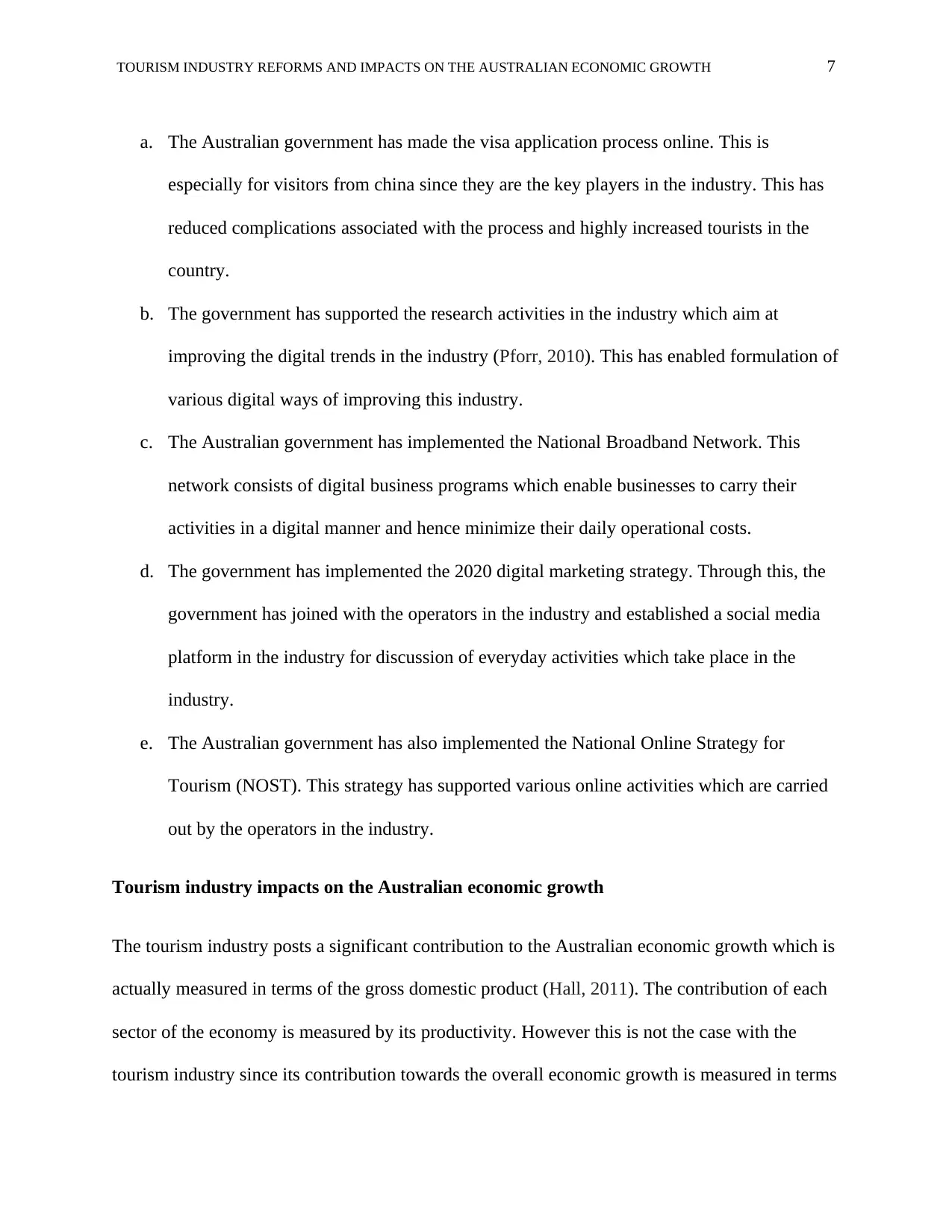
TOURISM INDUSTRY REFORMS AND IMPACTS ON THE AUSTRALIAN ECONOMIC GROWTH 7
a. The Australian government has made the visa application process online. This is
especially for visitors from china since they are the key players in the industry. This has
reduced complications associated with the process and highly increased tourists in the
country.
b. The government has supported the research activities in the industry which aim at
improving the digital trends in the industry (Pforr, 2010). This has enabled formulation of
various digital ways of improving this industry.
c. The Australian government has implemented the National Broadband Network. This
network consists of digital business programs which enable businesses to carry their
activities in a digital manner and hence minimize their daily operational costs.
d. The government has implemented the 2020 digital marketing strategy. Through this, the
government has joined with the operators in the industry and established a social media
platform in the industry for discussion of everyday activities which take place in the
industry.
e. The Australian government has also implemented the National Online Strategy for
Tourism (NOST). This strategy has supported various online activities which are carried
out by the operators in the industry.
Tourism industry impacts on the Australian economic growth
The tourism industry posts a significant contribution to the Australian economic growth which is
actually measured in terms of the gross domestic product (Hall, 2011). The contribution of each
sector of the economy is measured by its productivity. However this is not the case with the
tourism industry since its contribution towards the overall economic growth is measured in terms
a. The Australian government has made the visa application process online. This is
especially for visitors from china since they are the key players in the industry. This has
reduced complications associated with the process and highly increased tourists in the
country.
b. The government has supported the research activities in the industry which aim at
improving the digital trends in the industry (Pforr, 2010). This has enabled formulation of
various digital ways of improving this industry.
c. The Australian government has implemented the National Broadband Network. This
network consists of digital business programs which enable businesses to carry their
activities in a digital manner and hence minimize their daily operational costs.
d. The government has implemented the 2020 digital marketing strategy. Through this, the
government has joined with the operators in the industry and established a social media
platform in the industry for discussion of everyday activities which take place in the
industry.
e. The Australian government has also implemented the National Online Strategy for
Tourism (NOST). This strategy has supported various online activities which are carried
out by the operators in the industry.
Tourism industry impacts on the Australian economic growth
The tourism industry posts a significant contribution to the Australian economic growth which is
actually measured in terms of the gross domestic product (Hall, 2011). The contribution of each
sector of the economy is measured by its productivity. However this is not the case with the
tourism industry since its contribution towards the overall economic growth is measured in terms
Paraphrase This Document
Need a fresh take? Get an instant paraphrase of this document with our AI Paraphraser
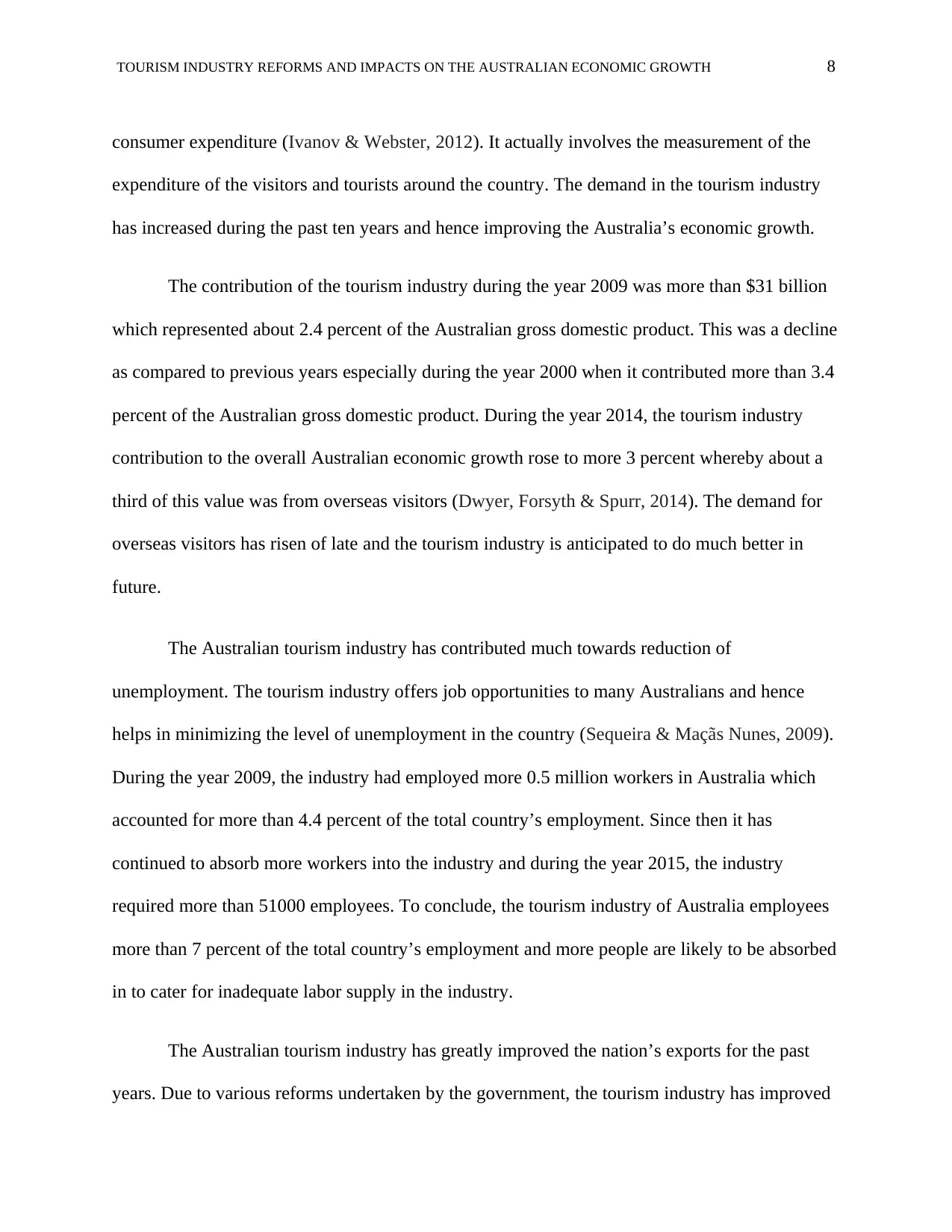
TOURISM INDUSTRY REFORMS AND IMPACTS ON THE AUSTRALIAN ECONOMIC GROWTH 8
consumer expenditure (Ivanov & Webster, 2012). It actually involves the measurement of the
expenditure of the visitors and tourists around the country. The demand in the tourism industry
has increased during the past ten years and hence improving the Australia’s economic growth.
The contribution of the tourism industry during the year 2009 was more than $31 billion
which represented about 2.4 percent of the Australian gross domestic product. This was a decline
as compared to previous years especially during the year 2000 when it contributed more than 3.4
percent of the Australian gross domestic product. During the year 2014, the tourism industry
contribution to the overall Australian economic growth rose to more 3 percent whereby about a
third of this value was from overseas visitors (Dwyer, Forsyth & Spurr, 2014). The demand for
overseas visitors has risen of late and the tourism industry is anticipated to do much better in
future.
The Australian tourism industry has contributed much towards reduction of
unemployment. The tourism industry offers job opportunities to many Australians and hence
helps in minimizing the level of unemployment in the country (Sequeira & Maçãs Nunes, 2009).
During the year 2009, the industry had employed more 0.5 million workers in Australia which
accounted for more than 4.4 percent of the total country’s employment. Since then it has
continued to absorb more workers into the industry and during the year 2015, the industry
required more than 51000 employees. To conclude, the tourism industry of Australia employees
more than 7 percent of the total country’s employment and more people are likely to be absorbed
in to cater for inadequate labor supply in the industry.
The Australian tourism industry has greatly improved the nation’s exports for the past
years. Due to various reforms undertaken by the government, the tourism industry has improved
consumer expenditure (Ivanov & Webster, 2012). It actually involves the measurement of the
expenditure of the visitors and tourists around the country. The demand in the tourism industry
has increased during the past ten years and hence improving the Australia’s economic growth.
The contribution of the tourism industry during the year 2009 was more than $31 billion
which represented about 2.4 percent of the Australian gross domestic product. This was a decline
as compared to previous years especially during the year 2000 when it contributed more than 3.4
percent of the Australian gross domestic product. During the year 2014, the tourism industry
contribution to the overall Australian economic growth rose to more 3 percent whereby about a
third of this value was from overseas visitors (Dwyer, Forsyth & Spurr, 2014). The demand for
overseas visitors has risen of late and the tourism industry is anticipated to do much better in
future.
The Australian tourism industry has contributed much towards reduction of
unemployment. The tourism industry offers job opportunities to many Australians and hence
helps in minimizing the level of unemployment in the country (Sequeira & Maçãs Nunes, 2009).
During the year 2009, the industry had employed more 0.5 million workers in Australia which
accounted for more than 4.4 percent of the total country’s employment. Since then it has
continued to absorb more workers into the industry and during the year 2015, the industry
required more than 51000 employees. To conclude, the tourism industry of Australia employees
more than 7 percent of the total country’s employment and more people are likely to be absorbed
in to cater for inadequate labor supply in the industry.
The Australian tourism industry has greatly improved the nation’s exports for the past
years. Due to various reforms undertaken by the government, the tourism industry has improved
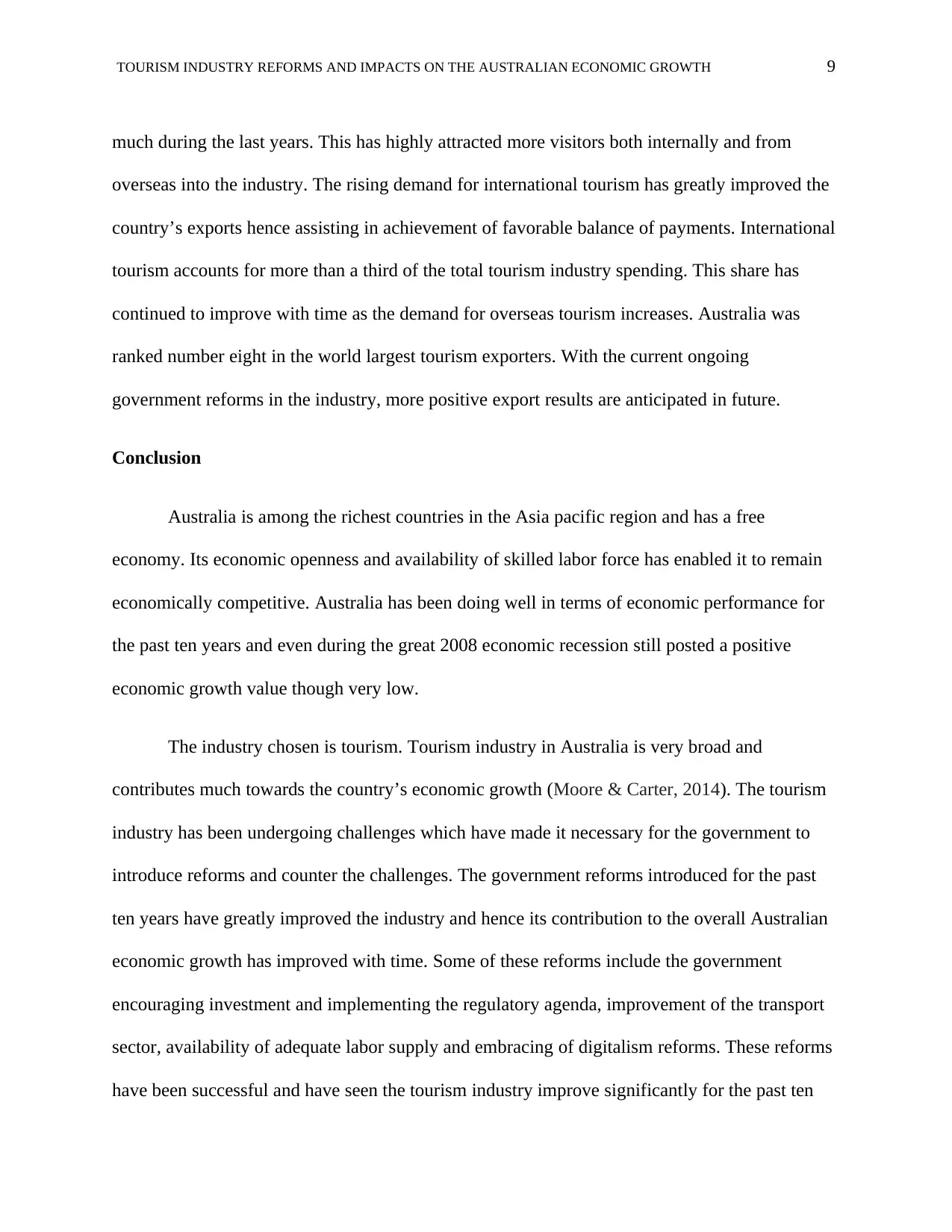
TOURISM INDUSTRY REFORMS AND IMPACTS ON THE AUSTRALIAN ECONOMIC GROWTH 9
much during the last years. This has highly attracted more visitors both internally and from
overseas into the industry. The rising demand for international tourism has greatly improved the
country’s exports hence assisting in achievement of favorable balance of payments. International
tourism accounts for more than a third of the total tourism industry spending. This share has
continued to improve with time as the demand for overseas tourism increases. Australia was
ranked number eight in the world largest tourism exporters. With the current ongoing
government reforms in the industry, more positive export results are anticipated in future.
Conclusion
Australia is among the richest countries in the Asia pacific region and has a free
economy. Its economic openness and availability of skilled labor force has enabled it to remain
economically competitive. Australia has been doing well in terms of economic performance for
the past ten years and even during the great 2008 economic recession still posted a positive
economic growth value though very low.
The industry chosen is tourism. Tourism industry in Australia is very broad and
contributes much towards the country’s economic growth (Moore & Carter, 2014). The tourism
industry has been undergoing challenges which have made it necessary for the government to
introduce reforms and counter the challenges. The government reforms introduced for the past
ten years have greatly improved the industry and hence its contribution to the overall Australian
economic growth has improved with time. Some of these reforms include the government
encouraging investment and implementing the regulatory agenda, improvement of the transport
sector, availability of adequate labor supply and embracing of digitalism reforms. These reforms
have been successful and have seen the tourism industry improve significantly for the past ten
much during the last years. This has highly attracted more visitors both internally and from
overseas into the industry. The rising demand for international tourism has greatly improved the
country’s exports hence assisting in achievement of favorable balance of payments. International
tourism accounts for more than a third of the total tourism industry spending. This share has
continued to improve with time as the demand for overseas tourism increases. Australia was
ranked number eight in the world largest tourism exporters. With the current ongoing
government reforms in the industry, more positive export results are anticipated in future.
Conclusion
Australia is among the richest countries in the Asia pacific region and has a free
economy. Its economic openness and availability of skilled labor force has enabled it to remain
economically competitive. Australia has been doing well in terms of economic performance for
the past ten years and even during the great 2008 economic recession still posted a positive
economic growth value though very low.
The industry chosen is tourism. Tourism industry in Australia is very broad and
contributes much towards the country’s economic growth (Moore & Carter, 2014). The tourism
industry has been undergoing challenges which have made it necessary for the government to
introduce reforms and counter the challenges. The government reforms introduced for the past
ten years have greatly improved the industry and hence its contribution to the overall Australian
economic growth has improved with time. Some of these reforms include the government
encouraging investment and implementing the regulatory agenda, improvement of the transport
sector, availability of adequate labor supply and embracing of digitalism reforms. These reforms
have been successful and have seen the tourism industry improve significantly for the past ten
⊘ This is a preview!⊘
Do you want full access?
Subscribe today to unlock all pages.

Trusted by 1+ million students worldwide
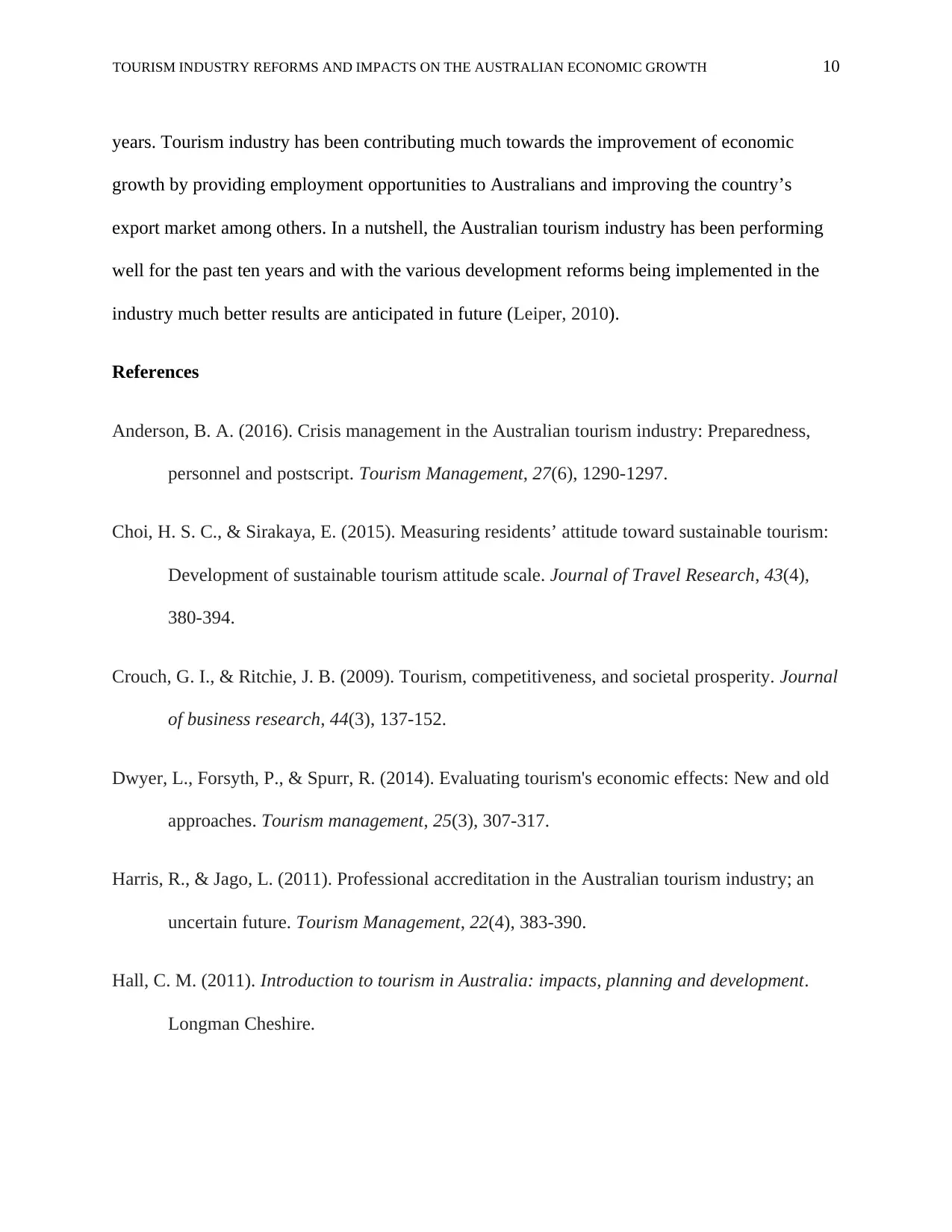
TOURISM INDUSTRY REFORMS AND IMPACTS ON THE AUSTRALIAN ECONOMIC GROWTH 10
years. Tourism industry has been contributing much towards the improvement of economic
growth by providing employment opportunities to Australians and improving the country’s
export market among others. In a nutshell, the Australian tourism industry has been performing
well for the past ten years and with the various development reforms being implemented in the
industry much better results are anticipated in future (Leiper, 2010).
References
Anderson, B. A. (2016). Crisis management in the Australian tourism industry: Preparedness,
personnel and postscript. Tourism Management, 27(6), 1290-1297.
Choi, H. S. C., & Sirakaya, E. (2015). Measuring residents’ attitude toward sustainable tourism:
Development of sustainable tourism attitude scale. Journal of Travel Research, 43(4),
380-394.
Crouch, G. I., & Ritchie, J. B. (2009). Tourism, competitiveness, and societal prosperity. Journal
of business research, 44(3), 137-152.
Dwyer, L., Forsyth, P., & Spurr, R. (2014). Evaluating tourism's economic effects: New and old
approaches. Tourism management, 25(3), 307-317.
Harris, R., & Jago, L. (2011). Professional accreditation in the Australian tourism industry; an
uncertain future. Tourism Management, 22(4), 383-390.
Hall, C. M. (2011). Introduction to tourism in Australia: impacts, planning and development.
Longman Cheshire.
years. Tourism industry has been contributing much towards the improvement of economic
growth by providing employment opportunities to Australians and improving the country’s
export market among others. In a nutshell, the Australian tourism industry has been performing
well for the past ten years and with the various development reforms being implemented in the
industry much better results are anticipated in future (Leiper, 2010).
References
Anderson, B. A. (2016). Crisis management in the Australian tourism industry: Preparedness,
personnel and postscript. Tourism Management, 27(6), 1290-1297.
Choi, H. S. C., & Sirakaya, E. (2015). Measuring residents’ attitude toward sustainable tourism:
Development of sustainable tourism attitude scale. Journal of Travel Research, 43(4),
380-394.
Crouch, G. I., & Ritchie, J. B. (2009). Tourism, competitiveness, and societal prosperity. Journal
of business research, 44(3), 137-152.
Dwyer, L., Forsyth, P., & Spurr, R. (2014). Evaluating tourism's economic effects: New and old
approaches. Tourism management, 25(3), 307-317.
Harris, R., & Jago, L. (2011). Professional accreditation in the Australian tourism industry; an
uncertain future. Tourism Management, 22(4), 383-390.
Hall, C. M. (2011). Introduction to tourism in Australia: impacts, planning and development.
Longman Cheshire.
Paraphrase This Document
Need a fresh take? Get an instant paraphrase of this document with our AI Paraphraser
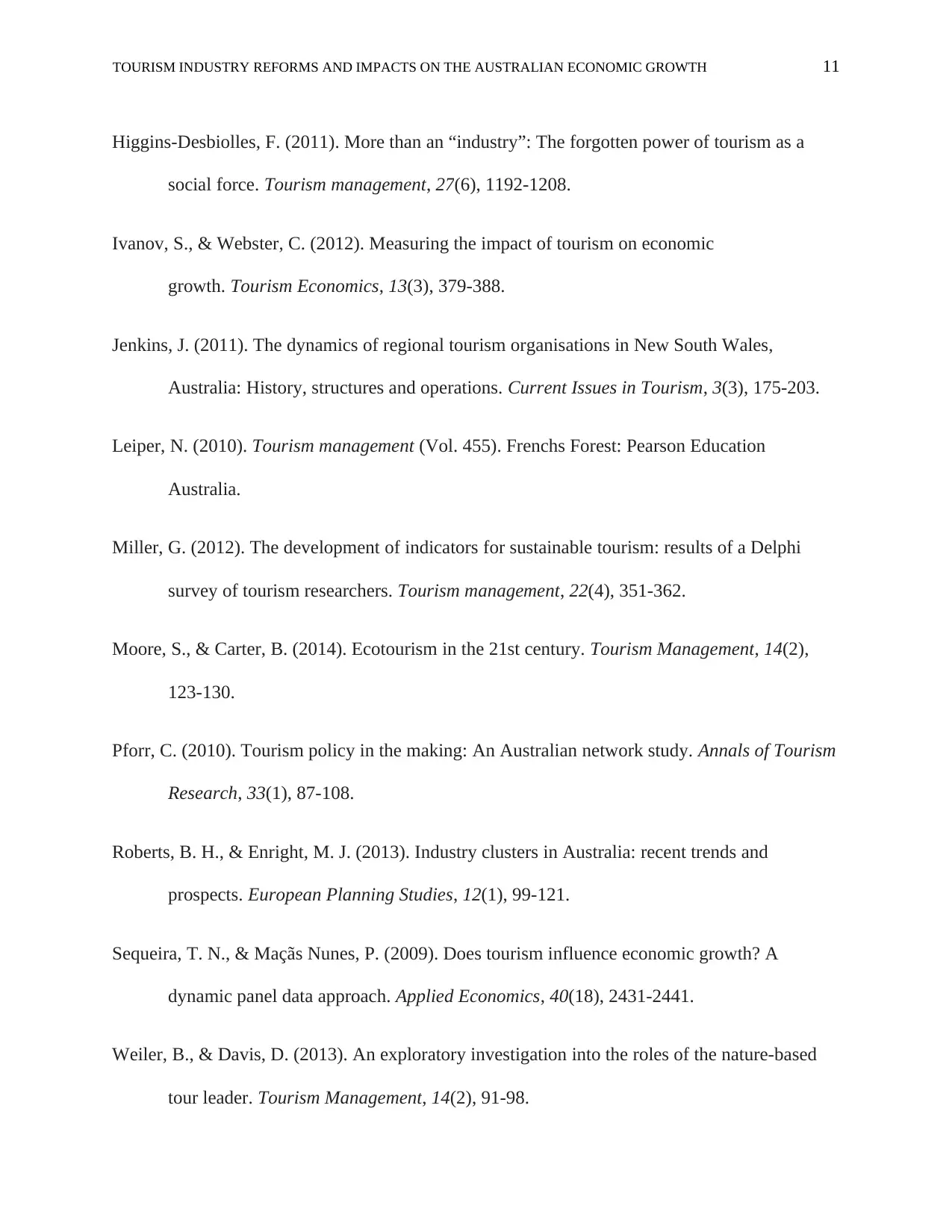
TOURISM INDUSTRY REFORMS AND IMPACTS ON THE AUSTRALIAN ECONOMIC GROWTH 11
Higgins-Desbiolles, F. (2011). More than an “industry”: The forgotten power of tourism as a
social force. Tourism management, 27(6), 1192-1208.
Ivanov, S., & Webster, C. (2012). Measuring the impact of tourism on economic
growth. Tourism Economics, 13(3), 379-388.
Jenkins, J. (2011). The dynamics of regional tourism organisations in New South Wales,
Australia: History, structures and operations. Current Issues in Tourism, 3(3), 175-203.
Leiper, N. (2010). Tourism management (Vol. 455). Frenchs Forest: Pearson Education
Australia.
Miller, G. (2012). The development of indicators for sustainable tourism: results of a Delphi
survey of tourism researchers. Tourism management, 22(4), 351-362.
Moore, S., & Carter, B. (2014). Ecotourism in the 21st century. Tourism Management, 14(2),
123-130.
Pforr, C. (2010). Tourism policy in the making: An Australian network study. Annals of Tourism
Research, 33(1), 87-108.
Roberts, B. H., & Enright, M. J. (2013). Industry clusters in Australia: recent trends and
prospects. European Planning Studies, 12(1), 99-121.
Sequeira, T. N., & Maçãs Nunes, P. (2009). Does tourism influence economic growth? A
dynamic panel data approach. Applied Economics, 40(18), 2431-2441.
Weiler, B., & Davis, D. (2013). An exploratory investigation into the roles of the nature-based
tour leader. Tourism Management, 14(2), 91-98.
Higgins-Desbiolles, F. (2011). More than an “industry”: The forgotten power of tourism as a
social force. Tourism management, 27(6), 1192-1208.
Ivanov, S., & Webster, C. (2012). Measuring the impact of tourism on economic
growth. Tourism Economics, 13(3), 379-388.
Jenkins, J. (2011). The dynamics of regional tourism organisations in New South Wales,
Australia: History, structures and operations. Current Issues in Tourism, 3(3), 175-203.
Leiper, N. (2010). Tourism management (Vol. 455). Frenchs Forest: Pearson Education
Australia.
Miller, G. (2012). The development of indicators for sustainable tourism: results of a Delphi
survey of tourism researchers. Tourism management, 22(4), 351-362.
Moore, S., & Carter, B. (2014). Ecotourism in the 21st century. Tourism Management, 14(2),
123-130.
Pforr, C. (2010). Tourism policy in the making: An Australian network study. Annals of Tourism
Research, 33(1), 87-108.
Roberts, B. H., & Enright, M. J. (2013). Industry clusters in Australia: recent trends and
prospects. European Planning Studies, 12(1), 99-121.
Sequeira, T. N., & Maçãs Nunes, P. (2009). Does tourism influence economic growth? A
dynamic panel data approach. Applied Economics, 40(18), 2431-2441.
Weiler, B., & Davis, D. (2013). An exploratory investigation into the roles of the nature-based
tour leader. Tourism Management, 14(2), 91-98.
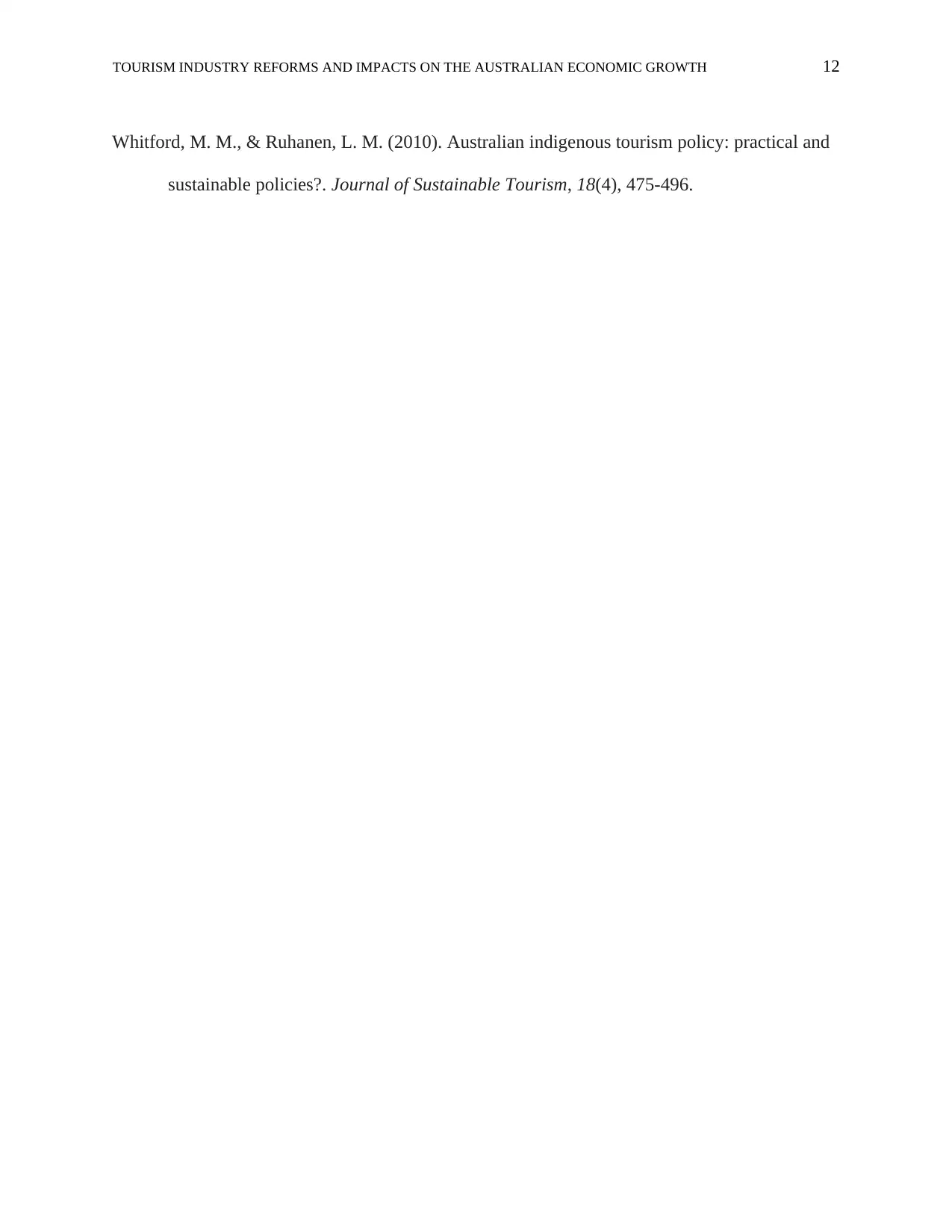
TOURISM INDUSTRY REFORMS AND IMPACTS ON THE AUSTRALIAN ECONOMIC GROWTH 12
Whitford, M. M., & Ruhanen, L. M. (2010). Australian indigenous tourism policy: practical and
sustainable policies?. Journal of Sustainable Tourism, 18(4), 475-496.
Whitford, M. M., & Ruhanen, L. M. (2010). Australian indigenous tourism policy: practical and
sustainable policies?. Journal of Sustainable Tourism, 18(4), 475-496.
⊘ This is a preview!⊘
Do you want full access?
Subscribe today to unlock all pages.

Trusted by 1+ million students worldwide
1 out of 12
Related Documents
Your All-in-One AI-Powered Toolkit for Academic Success.
+13062052269
info@desklib.com
Available 24*7 on WhatsApp / Email
![[object Object]](/_next/static/media/star-bottom.7253800d.svg)
Unlock your academic potential
Copyright © 2020–2025 A2Z Services. All Rights Reserved. Developed and managed by ZUCOL.




